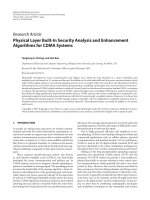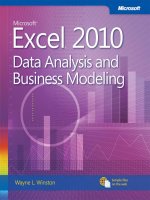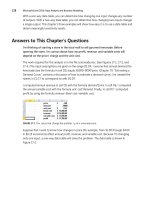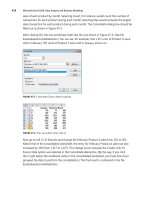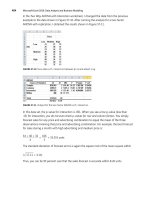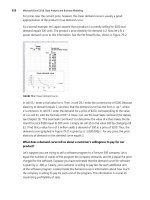Security analysis and business valuation on wall street
Bạn đang xem bản rút gọn của tài liệu. Xem và tải ngay bản đầy đủ của tài liệu tại đây (5.76 MB, 431 trang )
P1: a/b P2: c/d QC: e/f T1: g
fm JWBT244-Hooke March 4, 2010 15:32 Printer: Yet to Come
xii
P1: a/b P2: c/d QC: e/f T1: g
fm JWBT244-Hooke March 4, 2010 15:32 Printer: Yet to Come
Security Analysis and
Business Valuation
on Wall Street
i
P1: a/b P2: c/d QC: e/f T1: g
fm JWBT244-Hooke March 4, 2010 15:32 Printer: Yet to Come
Founded in 1807, John Wiley & Sons is the oldest independent publishing com-
pany in the United States. With offices in North America, Europe, Australia, and
Asia, Wiley is globally committed to developing and marketing print and electronic
products and services for our customers’ professional and personal knowledge and
understanding.
The Wiley Finance series contains books written specifically for finance and
investment professionals as well as sophisticated individual investors and their fi-
nancial advisors. Book topics range from portfolio management to e-commerce, risk
management, financial engineering, valuation, and financial instrument analysis, as
well as much more.
For a list of available titles, visit our Web site at www.WileyFinance.com.
ii
P1: a/b P2: c/d QC: e/f T1: g
fm JWBT244-Hooke March 4, 2010 15:32 Printer: Yet to Come
Security Analysis and
Business Valuation
on Wall Street
A Comprehensive Guide to
Today’s Valuation Methods
Second Edition
JEFFREY C. HOOKE
John Wiley & Sons, Inc.
iii
P1: a/b P2: c/d QC: e/f T1: g
fm JWBT244-Hooke March 4, 2010 15:32 Printer: Yet to Come
Copyright
C
1998, 2010 by Jeffrey C. Hooke. All rights reserved.
Published by John Wiley & Sons, Inc., Hoboken, New Jersey.
Published simultaneously in Canada.
No part of this publication may be reproduced, stored in a retrieval system, or transmitted in
any form or by any means, electronic, mechanical, photocopying, recording, scanning, or
otherwise, except as permitted under Section 107 or 108 of the 1976 United States Copyright
Act, without either the prior written permission of the Publisher, or authorization through
payment of the appropriate per-copy fee to the Copyright Clearance Center, Inc., 222
Rosewood Drive, Danvers, MA 01923, (978) 750-8400, fax (978) 646-8600, or on the web
at www.copyright.com. Requests to the Publisher for permission should be addressed to the
Permissions Department, John Wiley & Sons, Inc., 111 River Street, Hoboken, NJ 07030,
(201) 748-6011, fax (201) 748-6008, or online at />Limit of Liability/Disclaimer of Warranty: While the publisher and author have used their
best efforts in preparing this book, they make no representations or warranties with respect
to the accuracy or completeness of the contents of this book and specifically disclaim any
implied warranties of merchantability or fitness for a particular purpose. No warranty may
be created or extended by sales representatives or written sales materials. The advice and
strategies contained herein may not be suitable for your situation. You should consult with a
professional where appropriate. Neither the publisher nor author shall be liable for any loss
of profit or any other commercial damages, including but not limited to special, incidental,
consequential, or other damages.
For general information on our other products and services or for technical support, please
contact our Customer Care Department within the United States at (800) 762-2974, outside
the United States at (317) 572-3993 or fax (317) 572-4002.
Wiley also publishes its books in a variety of electronic formats. Some content that appears
in print may not be available in electronic books. For more information about Wiley
products, visit our web site at www.wiley.com.
Library of Congress Cataloging-in-Publication Data:
Hooke, Jeffrey C.
Security analysis and business valuation on Wall Street : a comprehensive guide to
today’s valuation methods / Jeffrey C. Hooke. — 2nd ed.
p. cm. — (Wiley finance series)
Includes bibliographical references and index.
ISBN 978-0-470-27734-8 (cloth)
1. Investment analysis. 2. Securities—Research. I. Title.
HG4529.H66 2010
332.63
2—dc22
2009042888
Printed in the United States of America.
10987654321
iv
P1: a/b P2: c/d QC: e/f T1: g
fm JWBT244-Hooke March 4, 2010 15:32 Printer: Yet to Come
Contents
Preface xiii
What Is Security Analysis? xiv
Recent Trends xv
Why Study Security Analysis and Business Valuation? xvii
Overview of the Contents xviii
What’s New in the Second Edition xviii
PART ONE
The Investing Environment 1
CHAPTER 1
Why Analyze a Security? 3
The Origins of Security Analysis 3
No Profit Guarantee 5
Day-to-Day Trading and Security Analysis 6
Herd Psychology and Security Analysis 6
Momentum Investors 7
Game Theory and Security Analysis 8
The Premise of Security Analysis 9
Scientific Method 10
Security Analysis Techniques 12
Basic Valuation Approaches 12
Other Valuation Approaches 14
Summary 16
CHAPTER 2
Who’s Practicing Security Analysis and Business Valuation? 17
Securities Firms and Their Analysts 18
Major Institutional Investors 20
A Dying Art? 21
Index Funds and Exchange-Traded Funds 24
Small Money Management Firms 25
Rating Agencies 26
Individual Investors: A Special Category 26
Business Valuation 28
Summary 28
v
P1: a/b P2: c/d QC: e/f T1: g
fm JWBT244-Hooke March 4, 2010 15:32 Printer: Yet to Come
vi
CONTENTS
CHAPTER 3
Seeking a Level Playing Field 29
Brief History of Securities Regulation 30
The Chief Regulator: The Securities and Exchange Commission 32
Sales and Trading Practices 34
Margin Regulation 37
The Life Cycle of a New Security Issue 37
Summary 49
CHAPTER 4
Other Sources of Information 51
The Business Media 51
The Free Internet 53
The Fee-for-Service Internet 53
Trade Associations, Consulting Firms, Government
Publications, and Financial Organizations 54
Credit Rating Agencies 54
Securities Firm Research 55
Newswires 56
Independent Expert Services 56
Summary 57
PART TWO
Performing the Analysis and Writing the Research Report 59
CHAPTER 5
Starting the Analysis 61
The Security Analysis Process 62
Model Research Report 63
The Analyst’s Responsibility 64
The Cascade of Projections 66
Selecting Stocks for Study: Top-Down versus Bottom-Up 67
Limited Time and Resources 68
The Margin of Safety 69
Summary 70
CHAPTER 6
Industry Analysis 73
Background 73
Organizing an Industry Analysis 75
Industry Classification 75
External Factors 81
Demand Analysis 86
Supply Analysis in the Industry Study 92
Profitability, Pricing, and the Industry Study 94
International Competition and Markets 95
Summary 98
P1: a/b P2: c/d QC: e/f T1: g
fm JWBT244-Hooke March 4, 2010 15:32 Printer: Yet to Come
Contents
vii
CHAPTER 7
Company-Specific Analysis 99
Systematic Approach of a Business Analysis 101
Overview and Business Description 106
Products and Markets Section 106
Production and Distribution 110
Competition 111
Other Topics Included in the Business Review 114
Summary 117
CHAPTER 8
Financial Statement Analysis of an Established Business 119
Beginning the Investigation 120
The Raw Materials of an Analysis 121
Evolution of the Approach to Financial Statements 122
Illustration of the Basic Approach 123
Review of Neiman Marcus Financial Analysis 135
Summary 137
CHAPTER 9
The Limitations of Accounting Data 139
Basic Accounting Issues 141
Global Issues 141
Company-Specific Accounting Issues 145
The Fundamental Objective of Public Companies 149
Case Study: Stability Corporation 150
Summary 163
CHAPTER 10
Financial Analysis and Company Classification 165
Company Classifications 166
The Mature Company 166
The Growth Company 167
The Cyclical Company 169
The Declining Company 175
The Turnaround 175
The Pioneer 175
Financial Games 176
Extra Shares Outstanding? 180
Summary 180
CHAPTER 11
Financial Projection Pointers 181
The Cascade of Projections 182
The Typical Financial Projection 182
Alternate Means of Forecasting 183
Critiquing the Huntsman Chemical Projection 185
Preparing Projections 186
P1: a/b P2: c/d QC: e/f T1: g
fm JWBT244-Hooke March 4, 2010 15:32 Printer: Yet to Come
viii
CONTENTS
Cyclical Company Forecast 189
Hockey Stick Phenomenon 190
Summary 192
PART THREE
Valuation and the Investment Decision 193
CHAPTER 12
Valuation Methodologies 195
Assessing Each Methodology 196
Applying Multiple Methodologies 197
Summary 198
CHAPTER 13
Intrinsic Value and Discounted Cash Flow 199
Issues in Applying Discounted Cash Flow 200
Discounted Cash Flow versus Relative Value 203
Discounted Cash Flow and the P/E Ratio 203
The Discounted Cash Flow Valuation Process 205
Summary 208
CHAPTER 14
Discounted Cash Flow: Choosing the Right Discount Rate 209
Beta 211
The Buildup Method for the Equity Rate of Return 212
Special Cases 213
Summary 215
CHAPTER 15
The Relative Value Approach 217
Real Estate Analogy 218
What’s the Right P/E Ratio? 218
Case Study: Temporary Staffing Services 219
Valuing an Initial Public Offering 222
Balance Sheet Items and Relative Value 223
How High Is Up? 223
Summary 223
CHAPTER 16
Marginal Performers 225
Defining the Problem Company 226
Small Companies and Relative Value 232
Summary 232
CHAPTER 17
The Mergers and Acquisitions Market, Security Analysis, and Valuation 233
Understanding Leveraged Buyouts 235
LBO Mechanics 236
P1: a/b P2: c/d QC: e/f T1: g
fm JWBT244-Hooke March 4, 2010 15:32 Printer: Yet to Come
Contents
ix
Case Study: Keane, Inc. 237
How Much Can the PE Firm Pay? 237
LBO Valuation and the Security Analysis of a Publicly
Traded Company 239
Strategic Takeover Values 240
Summary 241
CHAPTER 18
Sum-of-the-Parts Analysis 243
Background 243
Taxes Favor Spin-Offs versus Cash Sales 244
Sample Sum-of-the-Parts Analysis 245
Business Division Valuation 245
Nonoperating Corporate Assets and Liabilities 250
Unlocking Sum-of-the-Parts Values 250
Summary 251
CHAPTER 19
The Investment Recommendation 253
Summary Top-Down Analysis 255
Discounted Cash Flow Valuation 257
Relative Value/Sum-of-the-Parts Valuation Approach 259
Acquisition Value 261
Leveraged Buyout Method 262
Investment Recommendation 265
Summary 266
PART FOUR
Special Cases 267
CHAPTER 20
Private Equity 269
Industry Segmentation and Size 269
Fee Structure 270
Private Equity Does Not Beat the S&P 500 271
Private Equity Funds and Information Collection 271
Private Equity Changes to the Public Company
Valuation Methodology 272
Liquidity and Control Adjustments 273
Summary 277
CHAPTER 21
Natural Resource Companies 279
General Methodology 279
The Financial Reporting of Natural Resource Companies 281
Case Study: Encore Acquisition Company 284
Mining Companies 290
Summary 292
P1: a/b P2: c/d QC: e/f T1: g
fm JWBT244-Hooke March 4, 2010 15:32 Printer: Yet to Come
x
CONTENTS
CHAPTER 22
Financial Industry Stocks 293
Product Lines 295
The Nature of Financial Assets 296
Two Sets of Skills 298
Lending 298
Large Commercial Banks 304
Summary 307
CHAPTER 23
Insurance Companies 309
General Background 309
Principal Functions of an Insurance Company 311
Insurance Company Regulation 312
Financial Statement Analysis: Property and Casualty Company 313
Financial Statement Ratios 317
Life Insurance Companies 317
Summary 319
CHAPTER 24
Highly Speculative Stocks 321
Background 321
Discounted Cash Flow 323
Case Study: Ballard Power Systems 324
Venture Capital Markups and IPOs 328
Historical Perspective 329
Security Analysis, Technology Stocks, and Portfolio 329
Summary 330
CHAPTER 25
Distressed Securities and Turnarounds 331
Investment Opportunities 332
Screening Technique 333
Recognize the Options of an Unsuccessful Turnaround 334
Financial Analysis of a Company with Leverage Problems 335
The Investment Decision 338
Evaluating Turnarounds 339
Liquidations 340
Summary 342
CHAPTER 26
International Stocks 343
The Role of Security Analysis 343
American Depositary Receipts 345
Developed Country Markets 346
Relative Value Multiples 349
Summary 350
P1: a/b P2: c/d QC: e/f T1: g
fm JWBT244-Hooke March 4, 2010 15:32 Printer: Yet to Come
Contents
xi
CHAPTER 27
The Emerging Markets 351
Emerging Markets and Security Analysis 353
Stock Pricing Guidelines 357
Financial Projections 360
Emerging Market Equity Discount Rate 361
Relative Value in the Emerging Markets 364
Summary 366
PART FIVE
In Conclusion 367
CHAPTER 28
Asset Booms and Busts 369
The 2008 Crash: Contributing Causes 369
Collapse of the U.S. Housing Bubble 370
Failure of the Referees 371
The Certainty of Another Crash 375
How Might Security Analysis and Business Valuation Change? 377
Summary 378
CHAPTER 29
Closing Thoughts 379
Notes 383
About the Author 385
Index 387
P1: a/b P2: c/d QC: e/f T1: g
fm JWBT244-Hooke March 4, 2010 15:32 Printer: Yet to Come
xii
P1: a/b P2: c/d QC: e/f T1: g
fm JWBT244-Hooke March 4, 2010 15:32 Printer: Yet to Come
Preface
W
hen one hears the term security analyst, the impression that comes to mind
is a green-eye-shaded number cruncher, hunched over a desk piled high with
financial reports and computer screens. Sifting through reams of data, the analyst
looks endlessly for undervalued stocks trading on the public exchanges. In a narrow
sense that stereotype holds true, but the security analysis profession has spawned a
deliberate business valuation process that is copied by many disciplines, including
private equity, mergers and acquisitions, corporate appraisals, and government reg-
ulators. As a result, the users of the principles of security analysis represent a broad
cross section of individuals, such as:
Equity analysts at mutual funds, pension funds, commercial banks, endowments,
insurance companies, hedge funds, and sovereign wealth funds.
Private equity professionals at buyout funds, venture capital funds, and hedge
funds.
Corporate financial executives.
Investment bankers involved with mergers and acquisitions (M&A).
Institutional loan officers working with M&A and buyout transactions.
Business students at college and MBA schools.
Investor relations professionals at corporations and public relations firms.
Business appraisers, including those at appraisal firms, accounting firms, and
consultancies.
Lawyers who work with corporate clients on financial and tax matters.
Independent public accounting firms that must review securities pricing esti-
mates, business appraisals, and corporate valuation reports.
Government regulators at the IRS, SEC, FDIC, PCAOB, Comptroller of the
Currency, and Federal Reserve (and their international counterparts).
Bank trust and private wealth advisers.
Sophisticated individual investors.
Fortunes are made and lost on Wall Street based on advice from security analysts
and business valuation experts. They evaluate the prospects of companies issuing
common stock, borrowing money, or selling out in M&A transactions. For the seri-
ous investor, financial executive, or corporate manager, knowing how professionals
price companies is important. After all, an ownership in a business is only worth what
someone will pay for it. Since that someone is typically a full-time portfolio manager,
private equity firm, hedge fund, or corporate acquirer, understanding the evaluative
framework of such practitioners is a prerequisite for optimizing investment results.
The need for this book is more critical now than at any time since the depression-
ridden 1930s. Over the past 10 years, we have witnessed two global stock market
collapses and a financial crisis that required massive government intervention. A
xiii
P1: a/b P2: c/d QC: e/f T1: g
fm JWBT244-Hooke March 4, 2010 15:32 Printer: Yet to Come
xiv
PREFACE
major contributing factor was the failure of investors, lenders, and regulators to ad-
here to the basic principles of security analysis. The tactics of in-house due diligence,
contrary thinking, cross-checking, and recession-tested forecasting were sacrificed
at the altars of expediency, cost-cutting, and short-term profit. Hopefully, one re-
sult of this trillion-dollar calamity is a renewed emphasis on the fundamentals that
withstand the test of time and are outlined in this book.
WHAT IS SECURITY ANALYSIS?
Security analysis is the body of knowledge directed toward the valuation of a com-
pany (or its securities) in a rational, systematic way. It has a key principle: Over a
long period, such as two to three years, the price of a common stock reflects the busi-
ness prospects of the issuing firm and its economic environment. Over the short term,
however, powerful trading and emotional forces impact share values, so the pricing
of an equity (or the overlying business) is often a tug-of-war between the “long-term”
and “short-term” groups. Full-time practitioners are well versed in the principles and
methods of assessing equity interests in public and private companies. The results of
their research are aimed at providing superior investment performance.
Equity Values Reflect Uncertainty
The value of a security (or a company) depends upon so many highly variable
factors—and hence, is subject to such rapid changes—that pinpointing the validity of
one analyst’s reasoning aprioriis difficult. Furthermore, predictions are confounded
by, among other matters, unexpected changes in macroeconomic indicators such
as interest rates, unforeseen developments in company-specific matters such as new
competitors, and unusual shocks to an industry such as technology advances. All
three factors can sharply alter corporate pricing. At other times, an equity value
changes for reasons totally unrelated to the general economy, a company’s industry,
or its underlying business. For example, distinctive patterns in a public stock’s trading
activity prompt people to buy and sell, strictly on the notion that past trading trends
are predictive of future values.
The market price of any business thus represents a jumble of contradictory expec-
tations and hypotheses, influenced constantly by investors processing new data and
evaluating changing circumstances. If this analytical process isn’t difficult enough,
the careful public investor, private equity fund, or corporate acquirer must also
consider the human factors that affect financial asset values and react accordingly.
From time to time, the emotional sentiments of investors envelop either an individ-
ual firm, a specific industry, or the broad market. A herd psychology takes over the
pricing, defying rational explanation. Investors seeking an economic justification for
the resultant values are best advised to step out of the way of the ensuing stampede.
Since disparate investment styles and unpredictable future events both exercise a
major influence on equity prices, it is not surprising that many public and private eq-
uity managers cannot consistently select securities that outperform the general market
indexes. Indeed, according to a large body of academic theory, beating the market
on a regular basis is impossible. Public share prices reflect all available information,
P1: a/b P2: c/d QC: e/f T1: g
fm JWBT244-Hooke March 4, 2010 15:32 Printer: Yet to Come
Preface
xv
and private deals are widely shopped. As a result, no amount of study can achieve
above-average investment results, and those managers with superior investment
records are simply beneficiaries of the laws of chance. Sooner or later, the odds
catch up with them, and their performance returns to norm. The growth of equity
index funds and exchange-traded funds is evidence of the acceptance of this theory.
The Rationality Concept
As a field of study, security analysis rejects the idea that public equity investors are
doomed to earn the market return over time and nothing more. Rather, it dictates
that the selection of specific stocks for purchase or sale should be based upon a
rational analysis of investment values. Applying this philosophy in a disciplined
manner over the long term produces superior results. Advanced in a comprehensive
way by Benjamin Graham and David Dodd in their seminal work, Security Analysis,
this “rationality concept” has gained a wide following since the book’s publication
in 1934, and their step-by-step process of corporate valuation has been copied by
other disciplines, such as private equity, mergers and acquisitions, and business
appraisals.
RECENT TRENDS
When published in 1996, the first edition of Security Analysis and Business Valuation
on Wall Street was warmly received. Barron’s, the prestigious financial magazine,
called it a “welcome successor to Graham & Dodd,” and the CFA Institute, which
awards the chartered financial analyst designation, adopted a portion of the book
as required reading for the global CFA exam. At the suggestion of several business
professors, the first edition was modified into a textbook for MBA students, a rare
occurrence for a finance book written by a practitioner. And the book’s real-world
approach drew international interest: The Chinese translation, for example, had a
print run nearing the English version. Nevertheless, since 1996, the landscape for
evaluating investments has changed dramatically. These shifts include:
Expansion of the Internet. The expanded use of the Internet and the heightened
availability of broadband connections means that new public information
is transported instantaneously to market participants. With major investors
tied electronically to stock exchanges, trading in the affected securities takes
place milliseconds after the information is provided.
Increase in computing power, coupled with a decline in its cost. Immediately
upon its arrival, the new information is sliced and diced in innumerable
ways by sizable players with massive computing power. Employing sophis-
ticated software that incorporates the principles of security analysis, the
computers sift for pricing discrepancies in real time and execute trades ac-
cordingly, essentially replacing, for short periods anyway, the humans who
programmed them. Once an investor’s initial responses are processed, the
computers help practitioners consider long-term decisions by processing vast
amounts of numerical and related data.
P1: a/b P2: c/d QC: e/f T1: g
fm JWBT244-Hooke March 4, 2010 15:32 Printer: Yet to Come
xvi
PREFACE
Impact of two market crashes. The market crashes of 2000–2001 and 2008–
2009 showed that investors face a more hazardous environment than was
apparent at the time of the first edition. The failure of regulators, accounting
firms, and credit rating agencies—the market’s most important referees—to
stem the abuses leading to booms and busts brings new concerns to the
practitioner.
Extreme growth in derivatives. Derivative products, such as forwards, futures,
options, and swaps, have grown extremely quickly, quintupling in volume
over the past 10 years. This is due to improved technology in the structuring
and trading of such instruments and the fact that the size of the derivatives
market is not limited by the physical supply of the underlying securities.
The notional value of U.S. corporate bond swaps, for example, is several
times greater than all corporate bonds outstanding, and the notional value
of equity derivatives roughly equals the total value of publicly traded U.S.
common shares. Derivatives are used for both hedging and speculation.
Heightened use of independent experts. At the time of the first edition, the
study of a publicly traded business was heavily dependent on information
provided by management. Access to independent sources was limited due to
the practical considerations involving the time and cost of developing such
contacts. The Internet has reduced much of that dependence. Furthermore,
multiple companies now offer investors the opportunity to consult with
thousands of experts who offer insights on hundreds of companies and in-
dustries, usually at modest fees of a few hundred dollars per hour. Analysts
thus gain alternate views regarding corporate tactics and industry trends.
Globalization of security analysis. As the world’s major economies become in-
creasingly interdependent, the proper analysis of equity securities requires an
international bent that was unnecessary in the late 1990s. Trends in Western
Europe, Japan, Australia, and other developed areas become important to
the pricing of domestic equities. The popularity of emerging market stocks,
a moribund asset class just eight years ago, provides additional challenges.
Boost in private equity and M&A transactions. The assets controlled by private
equity have multiplied exponentially, and these funds have closed huge
volumes of transactions worldwide. Their analytical approach is closely
allied to security analysis. At the same time, public (and private) corporate
M&A deals grew many times over, as firms sought growth through buying,
rather than building.
Rise of hedge funds and short-selling. At the time of the first edition’s publi-
cation, hedge funds were bit players in the financial markets, but not for
long. The Internet-stock-driven collapse in equity prices from 2000 to 2001
convinced institutional investors that long-only funds had limitations and
that market-neutral returns were desirable. With the supposed ability to
profit in down markets by selling short and to make money in up markets
by going long, hedge funds offered such possibilities, although the 2008
market crash showed these claims to be illusory. Now accounting for up to
50 percent of trading on the New York Stock Exchange, these funds put a
spotlight on the practice of short-selling.
P1: a/b P2: c/d QC: e/f T1: g
fm JWBT244-Hooke March 4, 2010 15:32 Printer: Yet to Come
Preface
xvii
Valuation scandals at brokerage firms, accountants, and business appraisers.
The great bull market of the late 1990s was fueled in part by equity analysts
at the Wall Street brokerages, who issued overly optimistic reports on
speculative Internet firms and shaky technology companies. The analysts
compromised their research in order to curry favor with their supervisors
and to win advisory business for their banking colleagues. In 2003, the
brokerages paid $1.4 billion to settle charges that such research misled
investors. In accordance with the legal settlement, they instituted a number
of reforms. The sell-side analyst community was shaken by these events, and
its credibility, which was never pristine, will require years of rehabilitation.
At the same time, accountants and business appraisers were signing off on
lowball option prices for executives at private firms, and thus distorting
accounting results and income tax obligations.
Increased requirement for business valuation reports. These abuses prompted
the federal government to institute regulations mandating that public
companies (and soon-to-be-public companies) obtain third-party valuations
(independent of their outside auditors) for executive options, M&A-related
intangible assets, and other items. This requirement spilled over to many
private firms using outside auditors.
Growth of index funds, exchange-traded funds, and shadow indexing. Index
funds and exchange-traded funds (ETFs) offer low fees and, on behalf of
investors, buy a preset basket of stocks corresponding to a broad market
index, like the S&P 500, or a specific subindex, like the Russell Mid-Cap.
Now representing 30 percent of mutual funds’ assets, their growth shows
investors’ lack of faith in the ability of active managers to select stock
portfolios with premium returns. At the same time, many of these managers
have little confidence in their own skills; they buy stocks that mimic a
given index, cutting their risk of underperformance, but also reducing their
likelihood of overperformance. The practice is called shadow indexing or
hugging an index. The dual trends of index funds and shadow indexing
provide opportunities for analysts who do their homework, go against
passive selection, and take the long view.
WHY STUDY SECURITY ANALYSIS
AND BUSINESS VALUATION?
The stock market has a strong impact on economic policy, corporate decision mak-
ing, retirement planning, and employment, and yet many investors, businesspeople,
government officials, and students fail to understand business valuation, which is
the conceptual underpinning for stock prices. Indeed, a sizable number consider the
exchanges to be floating crap games. Speculative elements play a large role in the
equity markets, but the discipline of security analysis warrants the sustained interest
of many people.
On the international side, as more large developing countries, like China and
India, increasingly rely on equity markets to allocate capital to local businesses, they
must build a domestic capacity for business valuation.
P1: a/b P2: c/d QC: e/f T1: g
fm JWBT244-Hooke March 4, 2010 15:32 Printer: Yet to Come
xviii
PREFACE
OVERVIEW OF THE CONTENTS
To facilitate the reader’s understanding of the subject material, Security Analysis and
Business Valuation on Wall Street is divided into five parts.
Part One: The Investing Environment. Part One provides an overview of the
environment in which common stocks are issued, researched, bought, and
sold. In addition to examining why investors analyze companies in the first
place, we look at the roles of the players, rules and regulations of the equity
markets, activities surrounding an initial public offering, and sources of
investment information. The prices of publicly traded common stocks are
highly influential in setting values for private corporations, which are critical
for nonpublic investments, tax and accounting calculations, and a host of
other purposes.
Part Two: Performing the Analysis and Writing the Research Report. The in-
vestment merits of a particular business are evaluated through a methodical
approach. Both the history and the prospects of the company are consid-
ered. The sequence of this study and the format of the evaluation report are
discussed in Part Two.
Part Three: Valuation and the Investment Decision. At the conclusion of the
report, the equity analyst must answer two questions: (1) Is this company
fairly valued? and (2) Based on the previous answer, should I recommend
investing in the business? M&A, private equity, and other users have some-
what different actions to consider from their reports. Part Three provides
the necessary framework to deliver the answers.
Part Four: Special Cases. The model company for security analysis training is
a U.S.-based manufacturer with a history of improving sales and earnings.
Most firms don’t fit this model. Part Four reviews specific industries, private
equity tactics, and international markets.
Part Five: In Conclusion. Part Five looks at how investors are reacting to two
major market declines in 10 years. The book closes with some observations
and a few maxims.
WHAT’S NEW IN THE SECOND EDITION
The step-by-step methodical process needed to produce a reliable security analysis
(or business valuation) has not changed since the first edition, and has remained
fundamentally the same over the past 75 years. However, investing environments,
valuation techniques, and industry definitions evolve over time, requiring continued
modifications to the basic approach.
The second edition contains revisions to add insights and updates on such prac-
tical applications. Among them:
The investing environment. Chapters 1 through 4 provide updates on the new
environment, such as the dominance of commercial banks on Wall Street, the
inability of security analysts to foresee pricing bubbles, the effect of the 2008
P1: a/b P2: c/d QC: e/f T1: g
fm JWBT244-Hooke March 4, 2010 15:32 Printer: Yet to Come
Preface
xix
crash on the industry, the reliance of institutions on computerized models rather
than human analysts, and the continual reluctance of regulators to show initia-
tive in regulating. Chapter 4, “Other Sources of Information,” has been revised
to capture the use of the Internet and independent data services.
Starting the analysis, industry analysis, and company-specific analysis. Chap-
ters 5, 6, and 7 have been revised and updated. The principal themes remain the
same, and the chapters are more concise.
Financial statement analysis. Chapter 8 highlights, once again, the primary ele-
ments of this part of the company evaluation process and introduces an entirely
new case study from 2008. The chapter reminds practitioners to assume a reces-
sion in their forecasts, a necessity ignored by competing books and avoided by
many investors in their quest to close transactions. It also points out the use of
software to conduct financial statement analysis.
The limitations of accounting data. Chapter 9 includes a discussion on the recent
accounting scandals that made the security analyst’s job more difficult. The lack
of enforcement and punishment ensure that such scandals will repeat themselves
in the future.
Financial analysis and company classifications. Chapter 10 explicitly defines
pioneer, growth, mature, and declining companies and provides a methodology
for placing a subject firm in its category. Despite the wide use of this terminology
on Wall Street, many practitioners lack a firm foundation for making such
classifications.
Valuation methodologies. These chapters have been updated with new exam-
ples and cases. The application of each methodology (discounted cash flow,
comparable public companies, comparable M&A transactions, and leveraged
buyout) builds the foundation for making a decision, rather than just focusing
on the process. Chapter 17 acknowledges changes in leveraged buyout dynam-
ics. Chapter 18 adds commentary on the income tax ramifications of breaking
up a conglomerate.
The investment recommendation. Chapter 19 showcases how a proper evalua-
tion report reaches a buy or sell decision by applying the Wall Street approaches
explained in the book. The material is updated to 2009.
Special industries. Most companies do not fit the textbook model of a profitable,
domestic manufacturer. Chapters 21 to 25 provide new case studies in this
regard.
International. Commerce is increasingly global in nature, and the book reviews
changes that affect the investment decision process.
In addition, the second edition has four new chapters:
“Intrinsic Value and Discounted Cash Flow” (Chapter 13). Included previously
as a part of an earlier chapter, this topic now merits a separate treatment,
with added emphasis on the practitioner including a recession scenario in
any forecast.
“Discounted Cash Flow: Choosing the Right Discount Rate” (Chapter 14). The
popular capital asset pricing model (CAPM) has flaws in its application.
Chapter 14 reviews the flaws and provides a case study of using both the
P1: a/b P2: c/d QC: e/f T1: g
fm JWBT244-Hooke March 4, 2010 15:32 Printer: Yet to Come
xx
PREFACE
CAPM and an alternate approach to figure an appropriate discount rate for
a business. Rather than providing complex theories and formulas for what
is essentially a straightforward task, the book explains it in only 10 pages.
“Private Equity.” Chapter 20 shows how private equity firms and hedge funds
consider investments in private corporations, and how their approach differs
from an investor buying a security that is traded publicly on the New York
Stock Exchange. As a former private equity investor, I provide the inside
scoop.
“Asset Booms and Busts.” Having witnessed two market crashes within the past
decade, public stock investors, private equity firms, corporate acquirers, and
government regulators should work within a framework that anticipates a
downturn every 7 to 10 years. I discuss this topic in Chapter 28.
To download a valuation spreadsheet for DCF valuation and comparable com-
panies, visit the companion web site at www.wiley.com/go/hooke. Instructors may
also visit the Wiley Higher Ed site (www.wiley.com/college) for additional classroom
tools.
For convenience, the pronoun he has been used throughout this book to refer
nonspecifically to capital markets participants. The material herein will be equally
useful to both men and women who evaluate security issuers.
This book does not promise to help you obtain superior stock market results,
close better private equity deals, make optimal M&A transactions, or write the
best corporate appraisal reports. No book can honestly claim such results. Security
Analysis and Business Valuation on Wall Street provides a practical, well-rounded
view of business valuation and investment decision processes. After completing this
book, you are better prepared to make sound judgments and to confront the financial
markets’ numerous intrigues.
J
EFFREY
C. H
OOKE
Chevy Chase, Maryland
March 2010
P1: a/b P2: c/d QC: e/f T1: g
c01 JWBT244-Hooke February 24, 2010 14:54 Printer: Yet to Come
PART
One
The Investing Environment
Chapter 1 Why Analyze a Security?
Chapter 2 Who’s Practicing Security Analysis and Business Valuation?
Chapter 3 Seeking a Level Playing Field
Chapter 4 Other Sources of Information
1
P1: a/b P2: c/d QC: e/f T1: g
c01 JWBT244-Hooke February 24, 2010 14:54 Printer: Yet to Come
2
P1: a/b P2: c/d QC: e/f T1: g
c01 JWBT244-Hooke February 24, 2010 14:54 Printer: Yet to Come
CHAPTER
1
Why Analyze a Security?
This chapter covers the origin and evolution of security analysis, which
focused initially on publicly traded stocks and bonds. The herd psychology
and gamesmanship that are endemic to the capital markets are discussed,
along with modern valuation approaches.
S
ome investors analyze securities to reduce the risk and the gambling aspects of
investing. They need the confidence supplied by their own work. Other investors
seek value where others haven’t looked. They’re on a treasure hunt. Still others have
fiduciary reasons. Without documentation to justify an investment decision, clients
can sue them for malpractice should investment performance waver. Many investors
analyze shares for the thrill of the game. They enjoy pitting their investment acumen
against other professionals.
Security analysis is a field of study that attempts to evaluate businesses and
their securities in a rational way. By performing a rigorous analysis of the factors
affecting a company’s worth, security analysts seek to find equities that present a
good value relative to other investments. In doing such work, professional analysts
refute the efficient market theory, which suggests that a monkey throwing darts
at the Wall Street Journal will, over time, have a performance record equal to the
most experienced money manager. In fact, the proliferation of business valuation
techniques as well as advances in regulation and information flow contributes to the
market’s transparency. Nevertheless, on a regular basis, pricing inefficiencies occur.
An astute observer takes advantage of the discrepancies.
THE ORIGINS OF SECURITY ANALYSIS
Benjamin Graham and David Dodd made the business of analyzing investments
into a profession. With the publication of their book, Security Analysis, in 1934,
they offered investors a logical and systematic way in which to evaluate the many
securities competing for their investment dollars and their process was eventually
copied by M&A, private equity, and other business valuation professionals. Before
then, methodical and reasoned analysis was in short supply on Wall Street. The
public markets were dominated by speculation. Stocks were frequently purchased
3



